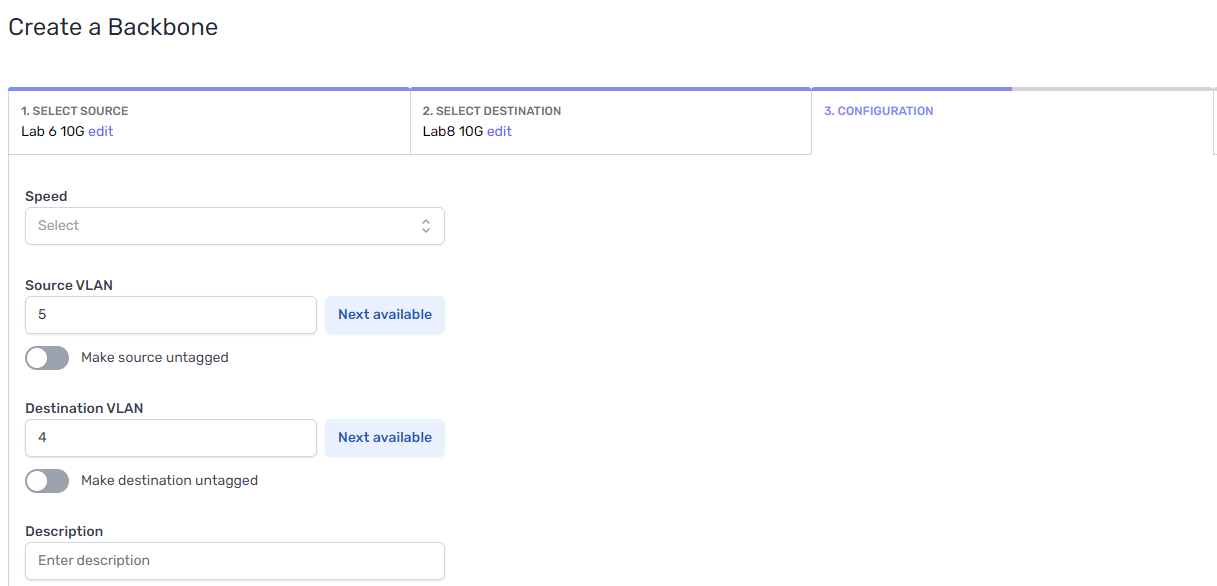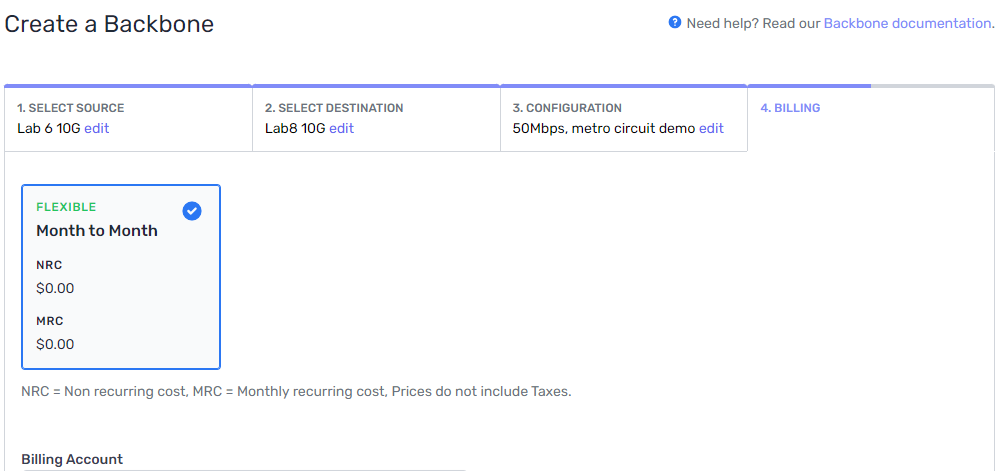Virtual Circuit Pricing, Terms, Billing
The billing terms that are available depend on the virtual circuit type and A and Z locations:
- Header
- Circuit type
- Metro
- Longhaul Dedicated
- Longhaul Usage-based
- Longhaul Hourly
- Flex Bandwidth
- BFD
- Backbone
(self to self) - 1
- 2
- 3
- Backbone
- ELMI
- Marketplace
(self to marketplace service provider) 4 - 3
- Marketplace
- GARP
- IX
(self to Internet exchange provider) 4 - 3
- IX
1: Supports hourly bursts.
2: Not currently supported on transregional virtual circuits with one end in Australia.
3: Not supported for reseller customers. Only supports connections between two U.S. locations.
4: There may be additional costs between you and the provider, which would be handled outside of PacketFabric.
Longhaul vs. Metro
At a very basic level, virtual circuits are divided into two billing types: metro vs. longhaul.
- Metro
- Metro virtual circuits are circuits that extend within the same metro market. For example, if the A side is in 165 Halsey Street, Newark, NJ (NYC1) and the Z side is in 60 Hudson Street, New York, NY (NYC8), then both sides fall within the NYC metro market. The virtual circuit is billed under “Metro Dedicated.”
- Longhaul
- Longhaul virtual circuits extend between two metro markets. When you select a Z-side interface that falls outside the metro in which your A-side is located, you are presented with long haul options: Dedicated, Usage-based, or Hourly (backbone virtual circuits only). Dedicated and hourly terms are unmetered; usage-based is metered.
Metro terms
Metro circuits are a free service ($0), regardless of capacity.
You do not select Metro terms as an option; they are automatically applied when you select a source and destination that are within the same metro market. You are only asked to select a capacity.


Canceling
You can delete the circuit at any time via the portal or API. For more information, see Delete a Virtual Circuit.
Renewing
All Metro circuits are month-to-month and automatically renew.
Extending the terms
Metro circuits are a month-to-month, free service. There is not an option to apply extended contract terms.
Changing capacity
Upgrading capacity
You cannot upgrade a Metro circuit or add an hourly burst. If you want to increase your capacity, you will need to delete it and create a new one. Consider this when provisioning the circuit.
Downgrading capacity
You cannot downgrade the capacity. You can edit the virtual circuit to apply a rate limit, which will set limits on your traffic. Alternatively, you can delete the circuit and create a smaller one.
Longhaul Usage-based
Longhaul Usage-based circuits are metered, meaning that you only pay for the data you use ($0.02/GB). Metered terms are beneficial when you have unpredictable, uneven traffic patterns and do not want to pay for capacity that you are not using. Their disadvantage is that if your data usage is unpredictable, then so are your costs.
When you provision a usage-based circuit, you are not asked to specify a capacity. Instead, the capacity depends on the size of the ports on which it lands. For example, a usage-based virtual circuit between a 1 Gbps port and a 10 Gbps port will have a 1 Gbps capacity.
Usage is calculated as aggregate in both directions.
You can use the Longhaul Usage pages under Billing and the virtual circuit details to track usage patterns and costs. For more information, see Longhaul Usage Page.
Canceling
You can delete the circuit at any time via the portal or API. For more information, see Delete a Virtual Circuit.
Renewing
Longhaul Usage-based circuits are not subject to monthly terms and do not require renewal.
Upgrading
Move to a Longhaul Dedicated service term
You can upgrade from usage-based to a Longhaul Dedicated service term of 1, 12, 24, or 36 months. Once you have upgraded to a Dedicated service term, you cannot return to usage-based. For more information, see Upgrade a Virtual Circuit.
Change capacity
You cannot upgrade capacity for a usage-based circuit, because the capacity is determined by the port size.
To limit capacity below the port size, you can edit the virtual circuit to apply rate limits for data coming in and out.
Longhaul Dedicated
Longhaul Dedicated is the most predictable and cost-effective option.
You are asked to select a capacity for the virtual circuit, and then you are billed a flat rate for that capacity each month. For example, if you create a 1 Gbps virtual circuit, you will be billed the same regardless of whether you use the circuit to full capacity 24/7, whether you use it sporadically, or whether you only use half its possible capacity. You are charged no additional fees or penalties for high usage.
Longhaul Dedicated pricing plans also come with discounts for longer service terms:
- Monthly
Discount: 0% - 12 Months
Discount: 4% - 24 Months
Discount: 9% - 36 Months
Discount: 14%
Canceling
When you delete a virtual circuit that is under contract, you may need to pay an early termination liability. See Cancel a Service.
Term completion
- 1-month term
- Circuits on a monthly plan automatically renew each month and can be deleted at any time.
- 12, 24, or 36-month term
- Within 90 days of when your contract completes, you will begin receiving reminders. If you do not renew for another extended term, your circuit automatically moves to a month-to-month term once your current term completes.
- At this time, you can do one of the following:
- Remain on a month-to-month contract. You will be charged the current month-to-month price of the circuit.
- Delete the circuit without paying an Early Termination Liability.
- You can also renew or extend the term (described below). You do not need to increase to a longer term. For example, if you are on a 12-month term, you can renew by extending another 12 months.
Extending or renewing the term
To extend service terms (e.g. move from a 12-month contract to a 24-month contract) or to renew service terms (e.g. add another 12 months to a current 12-month term), perform an Upgrade/Renewal action. For more information, see Upgrade or Renew a Virtual Circuit.
You can make the following term changes:
- 12 months (available to users on a monthly or 12 month plan)
- 24 Months (available to users on a monthly, 12-month, or 24-month plan)
- 36 Months (available to users on all plans)
Note the following:
- Both the original service and the upgraded service are prorated to the day.
- You cannot “downgrade” services terms (for example, move from a 24-month term to a 12-month term). Instead, you can wait for your current term to expire and then sign up for a new, shorter term.
- Extending virtual circuit terms essentially cancels your previous contract and begins a new one. For example, if you are currently on a 12-month contract, and then upgrade to a 36-month contract, you are adding 36 full months to your service terms.
Upgrading
Upgrading capacity for the term
To increase capacity for the remaining length of the service term, perform an upgrade. For more information, see Upgrade a Virtual Circuit.
Upgrades are prorated to the day.
Temporary capacity upgrades
You can upgrade capacity on an hourly basis by adding a capacity burst. A capacity burst is essentially an hourly term added on top of a dedicated term, with the same pricing structure and rules. For more information about implementing and managing a capacity burst, see Capacity Bursts.
Capacity downgrades
You cannot downgrade the capacity. You can edit the virtual circuit to apply a rate limit, which will set limits on your traffic. However, you are still billed for the capacity at which the virtual circuit was provisioned.
Longhaul Hourly
Longhaul Hourly terms are only available for backbone virtual circuits, and are useful for short-term projects or testing.
There is no limit to how many hours for which you can provision an hourly virtual circuit; we do not automatically cancel them after a certain amount of time has passed. You are billed for full hours, rounded up.
For information on hourly pricing, see Hourly Pricing Calculator.
Canceling
You can delete the circuit at any time via the portal or API. For more information, see Delete a Virtual Circuit.
We prorate to the hour, rounded up. All times are UTC.
For example, if you use an hourly circuit for 1 hour and 10 seconds, you are billed for 2 hours. If you use it for 1 hour and 59 minutes, you are also billed for 2 hours.
Renewing
Hourly circuits do not require renewal. We also do not automatically cancel them after a certain number of hours. It is up to you to manage how long an hourly circuit stays active.
Upgrading
Move to a Longhaul Dedicated service term
You can upgrade to a Longhaul Dedicated service term of 1, 12, 24, or 36 months. Once you have upgraded to a Dedicated service term, you cannot return to hourly. For more information, see Upgrade a Virtual Circuit.
Upgrades are prorated to the day.
Upgrade capacity
You cannot upgrade capacity on an hourly circuit. However, if you decide to upgrade to a Longhaul Dedicated service term, you can also upgrade your capacity when doing so.
Downgrade capacity
You cannot downgrade the capacity. You can edit the virtual circuit to apply a rate limit, which will set limits on your traffic. However, you are still billed for the capacity at which the virtual circuit was provisioned.
Flex bandwidth
Flex bandwidth is capacity purchased in bulk. For information on creating a flex bandwidth container, see Flex Bandwidth.
Canceling
You can delete the circuit at any time via the portal or API. For more information, see Delete a Virtual Circuit.
Renewing
Flex bandwidth circuits are not subject to monthly terms and do not require renewal.
Upgrading
You can upgrade and downgrade capacity at any time. From the virtual circuits page, click the circuit to open its side panel and then click Modify.
For more information, see Upgrade a Virtual Circuit.
Billing cycles for virtual circuits
All virtual circuits, regardless of term, receive a monthly invoice. Billing begins as soon as the circuit provisions.
Setting rate limits and disabling ports
You can edit a virtual circuit to apply a rate limit for data coming in and out. If necessary, the rate limits can be set to 0.
You can also disable the ports on which the circuit lands.
However, unless the circuit is usage-based, neither of these actions will affect how the circuit is billed. For example, if you set an in/out rate limit of 1 Gbps on a 5 Gbps virtual circuit, you are still billed for 5 Gbps.
